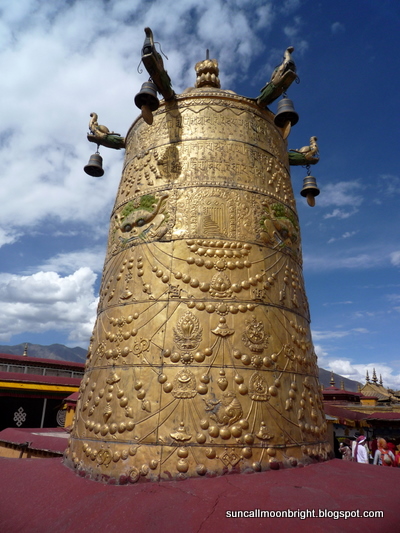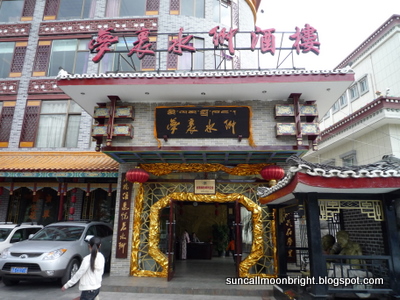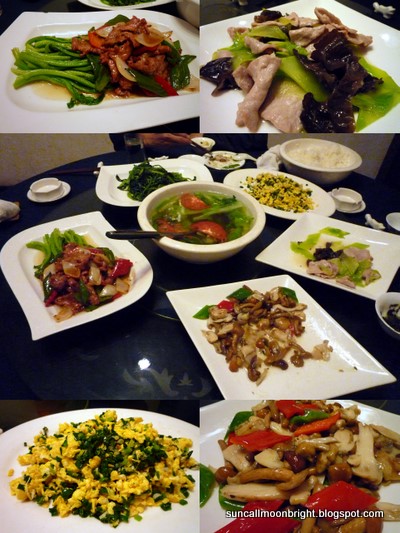View the previous post here or return to the trip index here.
03 Jun 2009
After the tiring morning ascent up Potala Palace, we went to view some local handicrafts, had lunch and rest in our hotel rooms before the next highlight, Jokhang Monastery (大昭寺, Dà Zhāo Sì). This is the first Buddhist Temple built in Tibet during the reign of the famous King, Songtsän Gampo, in 645 CE.

A spicy lunch!

A cute little hairy lamb outside the restaurant. No wait, did we just eat its brother?

At the handicraft shop. Tibet is rich in precious stones, so rich that gold is considered cheap. Many are of organic origin as they are fossilised corals of an ancient sea. Most famous of them is the "heavenly pearl". Here it is in its natural form.

A cut and polished "heavenly pearl". The different number of white rings (eyes) symbolise different meanings. These are so tradable that the Bank of China in Tibet accepts them as mortage objects.

A Tangka, a painted scroll depicting Buddha. These are painted with a mix of precious stones, gold, and animal material. The colours last for hundreds of years. They are preferred depictions of Buddhas because one can easily roll it up and store it when not in use. Unlike statues, they can be kept away if not venerated at home.

A bone flute made from the remains of a bad woman. It is said to be common practice to make an instrument out of the bones of bad people. When the instruments are played for ritualistic purposes, it is said to purify the soul of the bad person.
Arrival at Jokhang Monastery entrance. This is the spiritual centre of Tibetan Buddhism, being the first Buddhist temple built and is located in Barkhor Square with surrounding streets well paved and full of souvenir stalls. Jokhang Monastery is different from the other monastery and temples we have visited so far as it is pan-sectarian unlike the others that were all from the Gelug (Yellow Hat) Sect. There are depictions of the living Buddhas of other sects inside. Jokhang, along with the Potala Palace are part of the three sites in Lhasa jointly holding the UNESCO World Heritage site status.
It is said that king Songtsän Gampo originally intended to build this temple for his Nepalese wife as she was Buddhist. The chosen site was a lake. However no matter how much they tried to fill in the lake, they could never lay the foundations of the temple. It was only later when Tang princess Wencheng arrived that she figured in the lake was a demoness that was trashing about. To subdue the demoness, 12 large pillars of whole tree trunks were to driven into the lake as the temple's foundations to pin the 12 joints of the demoness. It worked and even today, there is one of these tree trunk pillars inside.
It is said that king Songtsän Gampo originally intended to build this temple for his Nepalese wife as she was Buddhist. The chosen site was a lake. However no matter how much they tried to fill in the lake, they could never lay the foundations of the temple. It was only later when Tang princess Wencheng arrived that she figured in the lake was a demoness that was trashing about. To subdue the demoness, 12 large pillars of whole tree trunks were to driven into the lake as the temple's foundations to pin the 12 joints of the demoness. It worked and even today, there is one of these tree trunk pillars inside.

The large pavement leading up to Barkhor Square where Jokhang Monastery is.

The entrance to the monastery, two pillars indicate that this is an important temple as well as a centre of learning.

A large drum looking object
A video of the devotees prostrating here. Some of the stones are smooth and shiny, being polished over the ages by the numerous act of prostrating.

It was a hot day, everyone was trying to get in the shade

In the first courtyard. I think the quarters with the balcony above was the living quarters of the 3rd Dalai Lama, Sönam Gyatso. Although pan-sectarian, the temple has been under the control of the Gelug sect.
The temple was defiled twice in history when Buddhism was actively prosecuted. In one of them, it was even turned into an animal slaughter house. However it has been restored each time. A hole in the wall is said to lead all the way to the lake below. Through this hole, a fated person with Buddhism is supposed to be able to still hear the sound of water waves deep below the temple. But this may no longer work as during one of those dark times the hole may have been choked by dead animal remains. In any case, I placed my ears by the hole but heard nothing.
Another interesting thing about this temple is that it houses one of the two most venerated statues of Buddha in Tibet. One was a statue of Buddha said to be made in the 8 year old image of him brought by the Nepalese princess to Tibet. The other was a statue of the Buddha said to be made in the 12 year old image of him brought by the Tang princess, Wencheng, to Tibet. I am unsure which it was inside but it sure attracted many people to circle it in a clockwise fashion. However, the legend we heard of these statues are debatable as it is widely accepted that there were no statues and depictions of Buddha during his lifetime.
Unfortunately, no photography was allowed inside.
Another interesting thing about this temple is that it houses one of the two most venerated statues of Buddha in Tibet. One was a statue of Buddha said to be made in the 8 year old image of him brought by the Nepalese princess to Tibet. The other was a statue of the Buddha said to be made in the 12 year old image of him brought by the Tang princess, Wencheng, to Tibet. I am unsure which it was inside but it sure attracted many people to circle it in a clockwise fashion. However, the legend we heard of these statues are debatable as it is widely accepted that there were no statues and depictions of Buddha during his lifetime.
Unfortunately, no photography was allowed inside.

Up on the third level, a wide angle view of the main courtyard


The view of the main street in front of Jokhang Monastery from the roof with the Potala Palace in the background

Potala Palace from Jokhang Monastery roof

A large golden bell

The streets of Barkhor Square, a good place to look for souvenirs at bargain prices. Never buy anything without bargaining!

Then it was time for dinner, our guides decided to take us to a different restaurant this time to try it out

Unfortunately it seems the usual one (where we had lunch) was tastier.
After dinner, at the recommendation of the tour guide, we decided to watch a performance by a local dance troupe that performed in the Beijing Olympics at the price of RMB 208 per pax. For full comfort it was held in a profession theatre that is oxygenated. The dances described the formation and aspects of Tibetan livelihood. They were focused on different elemental themes, professional, and full of colourful costumes.

The theatre

Finding our seats

It begins! An elaborate backdrop

A drummer on a mini-stage right beside the audience

The water theme performance
A short video clip of the water performance

Yaks in the land performance
A short video clip of the land performance

The harvest of grain

The mixing of yak/goat milk butter

Elaborate costumes

The fire theme, lamas debating the scripture

At almost two hours it is amazing how they seem so full of energy

A "yak" outside
No comments:
Post a Comment